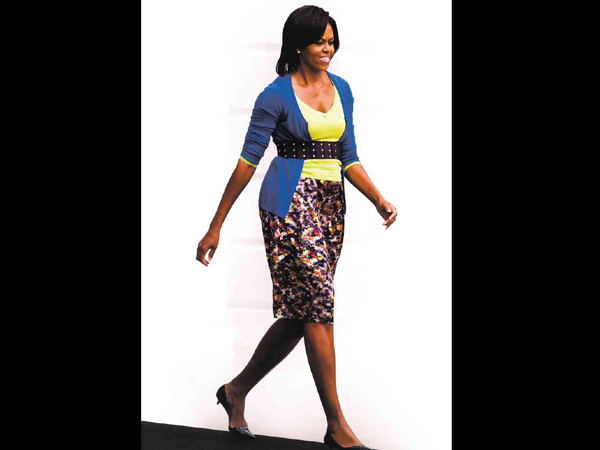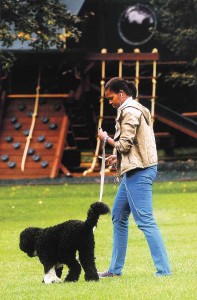 “Everyday Icon: Michelle Obama and The Power of Style”
“Everyday Icon: Michelle Obama and The Power of Style”
By Kate Betts
Clarkson Potter/Publishers, 2011
242 pages
Perhaps no American First Lady since Jackie Kennedy has held the world in such awe as Michelle Obama.
There’s rabid fascination in all things she wears—noted and followed with avidity in this wireless, digital era that was absent in Jackie’s time. She is lauded for subverting rules, for letting her personal style show and for proving to a generation of women that style and substance are not mutually exclusive.
Relevant subject
Fashion journalist Kate Betts in her new tome, “Everyday Icon: Michelle Obama and The Power of Style,” seeks to dissect Obama’s personal style, which seems to speak so well to this generation of women, its political connotations, and why her singularity is captivating as much as it is a relevant subject of discourse.
This interest in First Ladies and their style and fashion isn’t new. But there wasn’t much excitement in recent years until the Obama White House. Save for the (still) often derisive references to Hillary Clinton’s pantsuits by late-night comics, fashion hasn’t been exactly a hot topic in recent administrations, especially in Washington where fashion is largely considered a frivolity, a preoccupation more associated with “birdbrains.”
But that all changed when Michelle Obama, a Princeton- and Harvard-educated lawyer, came into the picture. In a place known for fitting in, she was poised to stand out.
For starters, she eschewed tradition by wearing relatively unknown designers at her husband’s inauguration. This became the norm, her choosing clothes designed by first-generation Americans: Isabel Toledo, Jason Wu, Thakoon Panichgul, Narciso Rodriguez, Maria Cornejo.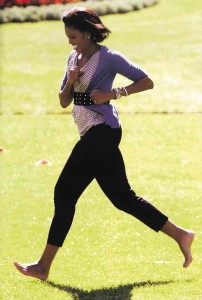
Breaking tradition
While they were picked clearly not for their provenance, it broke the tradition of First Ladies seeking the counsel of big-name, Seventh Avenue designers. To top it off, she added into the mix pieces from more democratic brands: J Crew, H&M, Gap, Target. (This made for a stark contrast to Sarah Palin’s controversial $150,000 one-day shopping spree at Nordstrom and Neiman Marcus. In the ’80s, Nancy Reagan was criticized for wearing a $10,000 dress to her husband’s inaugural.)
Michelle had America enthralled.
Betts notes that on the Obamas’ road to the White House, America wasn’t instantly smitten with Michelle. A former hospital administrator making $300,000 a year, she wore her sleek power suits at the start of the campaign, and after several weeks, “a worrisome percentage of voters still held reservations about [Barack’s] Ivy League wife… With a savvy sense of what’s necessa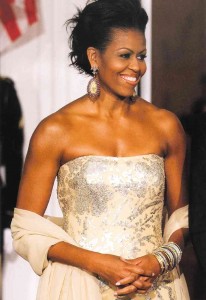 ry… [she] appeared to make a vital midcourse correction,” Betts writes. The power suits went out the window.
ry… [she] appeared to make a vital midcourse correction,” Betts writes. The power suits went out the window.
“Perhaps more than any First Lady before her, with the exception of Jackie Kennedy, Michelle Obama understands that style is much more than an aesthetic choice of political tool; it is the expression of one’s life, one’s way of being,” Betts notes.
Established look
In the world stage that depends a lot on imagery, Michelle is perhaps one of the few who hasn’t depended on a style makeover. While Nancy and Jackie arrived at the White House with an “established look and fluency in fashion,” Hillary was advised by De la Renta to wear more pinks to soften her image. Laura Bush also sought the veteran designer’s advice; her mother-in-law, Barbara Bush, went to Arnold Scaasi.
(Betts writes that Hillary also sought Jackie’s advice. When Hillary brought up the idea of fashion consultants, the style icon was horrified. “You have to be you,” she reportedly told the younger woman.)
Michelle’s clothes are commissioned for her by a Chicago boutique owner named Ikram Goldman. Unlike her predecessors, she “distances herself from the process.” She has never met most of her designers.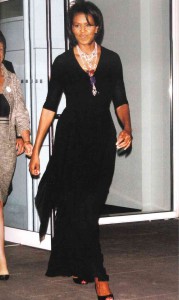
(The book has a fascinating section on how Michelle chose her dress for the inaugural, including the sketches and interviews from the short-listed designers. There are also some interesting trivia woven into the book.)
Curiously, even with her clout and connections, Betts—editor of Time Style & Design and former editor in chief of Harper’s Bazaar, fashion news director of Vogue and Paris bureau chief of Women’s Wear Daily—doesn’t get a quote from the elusive Goldman, who has never spoken to media of her relationship with the First Lady. Her eponymous boutique carries avant-garde designers favored by the likes of Michelle Obama.
Evolution
“First Ladies highlight the ongoing evolution of American women,” Betts writes, giving a historical account of American First Ladies’ styles in their respective eras. She notes that Dolley Madison and Jackie both used style and image “to advance their husbands’ agendas and cultivate their own influence.”
Eleanor Roosevelt and Hillary, meanwhile, “broke limits and threw themselves in the political fray.”
“Michelle 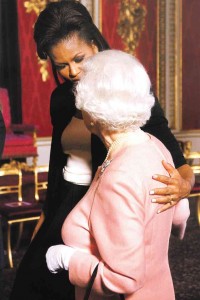 Obama seems so at home in both camps,” she writes. “The fact that [she] does not see style as an either/or choice is a powerful indication that the underlying assumptions about women’s roles and images have changed.”
Obama seems so at home in both camps,” she writes. “The fact that [she] does not see style as an either/or choice is a powerful indication that the underlying assumptions about women’s roles and images have changed.”
Betts continues, “As women’s ambitions have evolved, so have the faces that represent them. Michelle may have the glamour of a Jackie Kennedy, but as a style icon she speaks to a multicultural, post-feminist, wireless world… It’s almost as if she’s taking Hillary Clinton’s intelligence but dressing it in Jackie Kennedy’s clothes.”
De la Renta agrees. “The old kind of icons doesn’t exist today,” he tells Betts. “If you go on the street… probably there’s not even one person who knows who Grace Kelly is. That’s not really where we are today. What is important to a woman is to project her own sense of individuality—who she is—which Mrs. Obama does in an extraordinary way.”
Polarizing
Some of Michelle’s sartorial choices have also been polarizing. When she showed up in a sleeveless dress to listen to her husband speak before Congress, pundits were enraged. Betts notes, however, that Jackie also appeared in Congress in a similar dress, but it didn’t elicit the same reaction.
“Perhaps because [Jackie] didn’t convey the same message of strength and power” as the athletic, 5’11” Michelle, Betts hypothesizes. Again, there was similar reaction when Michelle emerged from Air Force One in hiking shorts; Hillary’s turn in shorts when her husband was in office was largely ignored. Michelle was also criticized for wearing a cardigan to meet the Queen and—gasp!—for touching the British monarch.
But it’s all her “letting women know that the word appropriate has changed,” says designer Michael Kors. She could have easily gotten into the Washington uniform of somber pantsuits, but “she chooses clothes that make her stand out, that says her individual style [and] not a fashion follower,” Betts writes.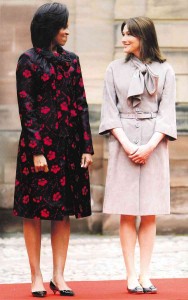
At 5’11” and the first African-American First Lady, Michelle would have easily stood out in Washington. But Betts makes special note of the woman’s gumption to dump “the whole stuffy etiquette” behind [Washington’s rules].
“If no one broke the rules, we still wouldn’t have the bikini,” Jenna Lyons, chief designer of J Crew, tells Betts. “There are no rules for her. She’s done everything her own way… I love that Michelle Obama is making the White House a little bit more approachable and real. I think that means a lot to people.”
Adds the designer Thakoon: “She is someone with authority and style that people can look up to… Her body is the body of a modern woman today. She wears dresses that are tight to the body but she’s not a size four, and it looks good on her… I think Michelle Obama is an icon. She has perhaps even surpassed Jackie O because the world is bigger now than it was then.”
Favorite image
There’s a real-ness to Michelle that is relatable to women, including Betts, who writes that her favorite image of the First Lady is that of her in jeans and sneakers, with an iPod, walking the family dog Bo.
 Betts digs far and deep into how this intriguing Michelle style was developed, tracking down her Chicago working-class roots, her life at Princeton, and into her role as a mother who gave up a lucrative career to throw her support behind her husband’s political ambitions.
Betts digs far and deep into how this intriguing Michelle style was developed, tracking down her Chicago working-class roots, her life at Princeton, and into her role as a mother who gave up a lucrative career to throw her support behind her husband’s political ambitions.
“One of the reasons she exemplifies the power of style is that she is helping liberate a generation of women from the false idea that style and substance are mutually exclusive,” Betts writes.
“She is defining the dress code for the ’you can’t have it all’ generation, a generation that wants to be paid as much as men, and have the same opportunities as men, but doesn’t want to dress like them or to define the principle of femininity in male terms.”
Available in National Book Store

